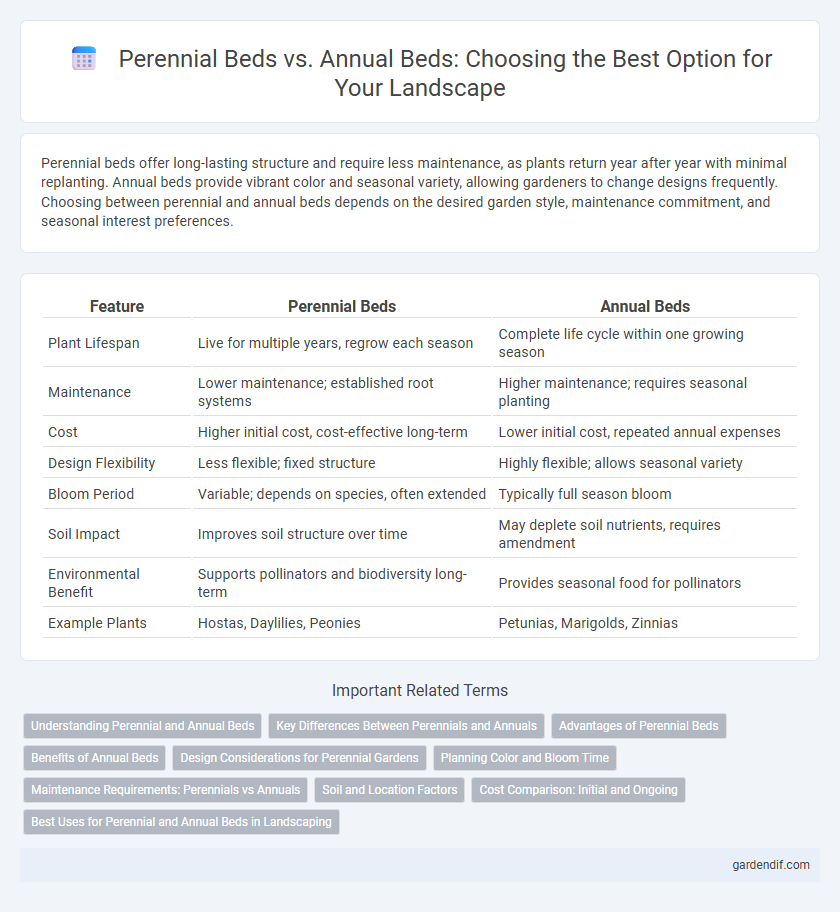
Perennial Beds vs Annual Beds Illustration
Perennial beds offer long-lasting structure and require less maintenance, as plants return year after year with minimal replanting. Annual beds provide vibrant color and seasonal variety, allowing gardeners to change designs frequently. Choosing between perennial and annual beds depends on the desired garden style, maintenance commitment, and seasonal interest preferences.
Table of Comparison
| Feature | Perennial Beds | Annual Beds |
|---|---|---|
| Plant Lifespan | Live for multiple years, regrow each season | Complete life cycle within one growing season |
| Maintenance | Lower maintenance; established root systems | Higher maintenance; requires seasonal planting |
| Cost | Higher initial cost, cost-effective long-term | Lower initial cost, repeated annual expenses |
| Design Flexibility | Less flexible; fixed structure | Highly flexible; allows seasonal variety |
| Bloom Period | Variable; depends on species, often extended | Typically full season bloom |
| Soil Impact | Improves soil structure over time | May deplete soil nutrients, requires amendment |
| Environmental Benefit | Supports pollinators and biodiversity long-term | Provides seasonal food for pollinators |
| Example Plants | Hostas, Daylilies, Peonies | Petunias, Marigolds, Zinnias |
Understanding Perennial and Annual Beds
Perennial beds contain plants that live for multiple years, offering consistent structure and reducing the need for replanting every season. Annual beds comprise plants that complete their life cycle in one growing season, providing vibrant, rapidly changing color but requiring yearly replacement. Understanding the lifecycle and maintenance demands of perennial versus annual beds helps create a balanced, sustainable landscape design.
Key Differences Between Perennials and Annuals
Perennial beds contain plants that live for multiple growing seasons, providing long-term structure and reducing replanting efforts, while annual beds consist of plants that complete their life cycle in one season, offering vibrant, seasonal color changes. Perennials often require an initial investment in soil preparation and maintenance but benefit from established root systems that promote resilience and soil stability. Annuals provide flexibility for design changes each year and are ideal for filling gaps or creating bold, temporary displays with rapid growth and flowering.
Advantages of Perennial Beds
Perennial beds offer long-term cost savings and reduced maintenance since plants come back year after year without the need for replanting. They provide consistent structure and seasonal interest, supporting local ecosystems by attracting pollinators and beneficial insects. These beds improve soil health over time through developed root systems, enhancing water retention and reducing erosion.
Benefits of Annual Beds
Annual beds offer vibrant, ever-changing color throughout the growing season, enhancing garden aesthetics with a variety of textures and blooms. They require less maintenance in terms of soil preparation and can adapt quickly to new design trends or seasonal themes. Annual plants also attract beneficial pollinators, improving biodiversity and supporting a healthy garden ecosystem.
Design Considerations for Perennial Gardens
Perennial beds require careful design planning to ensure continuous seasonal interest, incorporating plants with staggered bloom times, varied textures, and complementary colors. Soil preparation and long-term maintenance strategies must account for root expansion and nutrient needs to support healthy growth year after year. Integrating native perennials improves ecological resilience while reducing water usage and pest management efforts in sustainable landscape designs.
Planning Color and Bloom Time
Perennial beds offer a structured approach to planning color and bloom time, with plants providing consistent seasonal interest year after year, especially through staggered bloom periods from spring to fall. Annual beds allow for rapid color shifts and customization each season, enabling landscapers to target specific bloom times and vibrant hues that complement the overall garden design. Combining both bed types strategically enhances landscape diversity, maintaining continuous color and dynamic visual appeal throughout the growing season.
Maintenance Requirements: Perennials vs Annuals
Perennial beds require lower maintenance compared to annual beds because they return year after year, reducing the need for replanting and soil preparation. Annual beds demand more frequent care, including regular planting, watering, and fertilizing to ensure vibrant blooms throughout the growing season. Mulching and deadheading in perennial beds help maintain plant health with less intensive upkeep compared to the continuous management required for annuals.
Soil and Location Factors
Perennial beds require well-drained, nutrient-rich soil with consistent moisture retention to support long-term root development, while annual beds benefit from nutrient-rich, loose soil that allows easy root expansion each season. Location factors for perennials include stable sunlight exposure and protection from harsh winds to ensure plant longevity, whereas annual beds can be placed in more variable locations due to their shorter growing cycles. Soil pH and texture should be tailored accordingly, with perennials often thriving in slightly acidic to neutral soil, and annuals accommodating a broader pH range depending on species.
Cost Comparison: Initial and Ongoing
Perennial beds have higher initial costs due to plant prices and soil preparation but offer lower ongoing maintenance expenses because they return each year without needing replacement. Annual beds require lower upfront investment but incur continual costs as plants must be replanted every season, alongside ongoing watering, fertilizing, and pest control. Over time, perennial beds present cost savings in labor and replacement plants, making them a more economical choice for sustainable landscaping.
Best Uses for Perennial and Annual Beds in Landscaping
Perennial beds are ideal for low-maintenance landscaping, providing long-lasting structure and consistent seasonal blooms that enhance garden stability and biodiversity year after year. Annual beds excel in adding vibrant, customizable color and variety, allowing for design flexibility and seasonal themes that can be easily changed each growing season. Combining perennial and annual beds optimizes garden aesthetics by balancing permanent foundations with dynamic, eye-catching displays.
Perennial Beds vs Annual Beds Infographic

 gardendif.com
gardendif.com